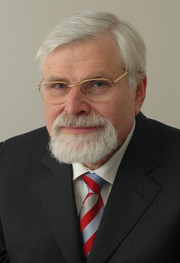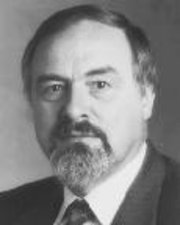
Speaker's Bureau
Leaky Modes and High-Frequency Effects Microwave Integrated Circuits

Prof. Dr. David Jackson
University of Houston
Department of Electrical and Computer Engineering
N 308 Engineering Building 1
Houston, Texas 77204-4005
Tel.: +713-743-4426
Fax: +713-743-4444
E-Mail: djackson@uh.edu
Web: http://www.egr.uh.edu/ece/faculty/jackson/
This presentation will overview the propagation and excitation of leaky modes on planar microwave integrated circuit structures, including microstrip line, covered microstrip line, and stripline with an air gap. A leaky mode is a mode that leaks power as it propagates, with the leakage occurring into the modes of the surrounding substrate structure and in some cases also directly into space (for an open structure). The excitation of leaky modes on planar printed-circuit transmission lines leads to signal attenuation due to radiation, crosstalk, and interference effects (since the leaky modes can interfere with the desired mode of propagation). Methods for calculating the properties of these leaky modes will be presented, together with ways of predicting when these effects might occur. For some structures the leakage only occurs at high frequency, while for other structures it occurs for all frequencies. The calculation of the current excited on a printed-circuit line by a source (such as a gap voltage source or a probe feed) is one way to explicitly determine the level of spurious effects that will be observed in an actual circuit. Analysis reveals that in addition to leaky modes, a practical source will also excite other types of waves at high frequency, which form the remaining part of the »continuous spectrum« that is not accounted for by the leaky modes. These other wave types, call »residual waves« may also contribute to spurious effects such as interference at high frequencies. Time-domain results show that pulse propagation on a printed-circuit line may be adversely affected by the existence of leaky modes, resulting in signal attenuation and distortion.
Geometrical Concepts in Teaching Electromagnetics

Prof. Dr. techn. Dr. h. c. Peter Russer
Technische Universität München
Department of Electrical Engineering and Information Technology
Institute for High-Frequency Engineering
Arcisstr. 21, 80333 München, Germany
North Buildings, Building N5, Room N5504
Tel.: +49-89-289-28390
Fax: +49-89-289-23365
E-Mail: russer@tum.de
Web: http://www.hft.ei.tum.de/
The presentation deals with the application of exterior differential forms in teaching electromagnetics. The formulation of electromagnetic theory can be simplified and the ability to create concepts can be improved by the use of geometrical methods. The exterior differential calculus establishes a direct connection to geometrical images and provides additional physical insight. Exterior differential calculus has simple and concise rules for computation. Furthermore, the objects of differential calculus have a clear geometrical significance and the geometrical laws of electromagnetics assume a simple and elegant form. The differential form representation supplies additional physical insight in addition to the conventional vector picture. After introducing exterior differential forms, Maxwell’s equations are presented in this notation. The exterior derivative is introduced. Poincarés lemma, Stokes’ theorem, electromagnetic potentials and Green’s functions are discussed. It is shown that the exterior calculus simplifies the treatment of curvilinear coordinates. An example of the formulation of the radiation problem is given.
Multi-Level Modeling for Complex Microwave/High-Speed Design

Prof. Dr. Wolfgang J. R. Hoefer, Principal Scientist
Director, IHPC Independent Investigatorship Program
A-Star, Institute of High Performance Computing
1 Fusionopolis Way, #16-16 Connexis
Singapore 138632, Singapore
Tel: 011 65 6419 1429
Fax: 011 65 6463 5176
E-Mail: w.hoefer@ieee.org
Complex communication and information systems operating in the Gigahertz range often combine multiple analog and digital functions. The design of such systems must capture all electromagnetic effects and interactions that impact their performance. However, it is impossible to model such systems globally at the field and device levels. Therefore, designers must take a hierarchical approach (top-down design) by which the system is conceived at a high level of abstraction and in behavioral terms. The specifications for its functional components are formulated at the network or circuit level. They, in turn, define a physical structure that requires frequency- or time-domain electromagnetic field analysis. Once the functional components have been realized, their actual physical behavior must be analyzed or measured, including possible parasitic interactions between them, and abstracted into realistic (as opposed to initially specified) behavioral models that accurately predict their impact on overall system performance (bottom-up verification). This methodology also addresses signal integrity, packaging, interconnects, electromagnetic compatibility (EMC), and thermal issues.
The purpose of this lecture is to familiarize our members with evolving design approaches for systems of large technological and functional complexity, and to demonstrate how microwave modeling and design practices can be integrated into a wider flexible multi-level modeling environment. Techniques for interfacing models at the behavioral, network, circuit and field levels will be demonstrated. They range from order reduction of field models to the coupling of field- and circuit solvers, extraction of equivalent circuits from field solutions and measurements, behavioral representation by neural networks, and the linking of electromagnetic and thermal solvers. The key is to describe different parts of a complex structure by the most appropriate model of lowest possible order, while maintaining a two-way correspondence between functional behavior and physics across the modeling hierarchy.
Unification of Numerical Methods: A General Mathematical Framework for Derivations and New Scheme Developments

Prof. Zhizhang (David) Chen, Ph.D, P.Eng.
Dalhousie University
Department of Electrical and Computer Engineering
1360 Barrington St.
Halifax, Nova Scotia
Canada B3J 2X4
Tel.: +1 (902) 494-6042, Secretary: -3996
E-Mail: z.chen@dal.ca
Web: http://myweb.dal.ca/zdchen/
Electromagnetic field modeling and simulation have become increasingly popular for accurate designs in modern electrical and electronic engineering, thanks to the drastic advances in computer technology. They have been applied in many areas, in particular in industrial designs where the reduction in the number of design cycles or product's time-to-market has become very critical in a global competitive environment. For instance, in antennas, most of the practical designs are now done with simulations using commercially available software packages before actual prototyping and testing. In high-frequency electronic circuits, due to the fact that analyses based on simple circuit theory are no longer adequate, electromagnetic simulators are increasingly being used to improve design accuracy. In biomedical engineering, numerical simulations are often required to compute dosimetry in a biological body since an actual measurement is either difficult or impossible.
Many numerical methods have been developed so far for electromagnetic modeling and simulation. They present different approaches to the approximate solutions of the electromagnetic field governing equations, namely, Maxwell's equations. They include frequency-domain methods such as the finite-difference frequency-domain (FDFD) method, finite-element (FEM) method and the conventional method of moments (MoM), and the time domain methods such as finite-difference time-domain (FDTD) method, transmission-line-matrix (TLM) method, time-domain finite-element (TD-FEM) method, and time-domain integral formulations. On one hand, these methods have been proven to be effective in solving electromagnetic structure problems with their respective advantages and disadvantages. On the other hand, they appear to have been derived on different mathematical bases and their solution procedures also appear to be different from each other, presenting challenges and difficulty for students, beginners and even practitioners in understanding and applying them.
This lecture is intended to show otherwise: all the numerical methods can be generalized or derived with the method of the weighted residuals, or method of moments; As the result, an easy way to understand and apply numerical methods is presented and a new perspective on numerical methods and a new way to develop innovative numerical methods are shown. In particular, unifying concepts among numerical methods are described and based on the concepts emerging numerical methods such as meshless, hybrid and multilevel techniques are demonstrated.